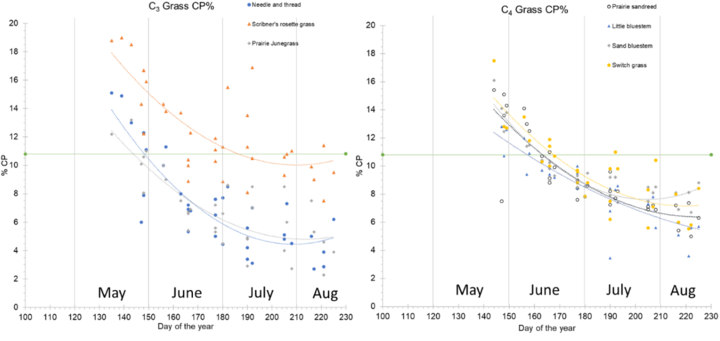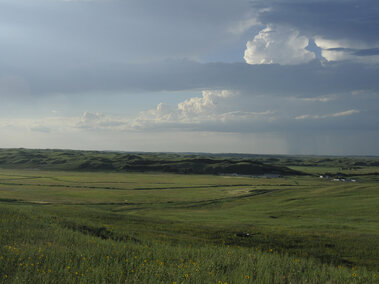Nutritive Value of Individual Plant Species in the Sandhills
Mitch Stephenson and Kate Zander
In the Nebraska Sandhills, over 720 different plant species have been identified across the landscape. On upland Sands ecological sites in the Sandhills, warm- and cool-season grass species provide a majority of the annual plant biomass. Long-term data (2004 to 2023) collected at the UNL Gudmundsen Sandhills Lab (GSL) indicates that grasses make up nearly 80% of total plant biomass (30% cool-season grasses and 50% warm-season grasses), with forbs (13%), current-year growth of shrubs (3%), and sedges (4%) making up the remainder. These plants provide the primary forage resource for cattle grazing in the Sandhills during the growing season. Understanding variability in nutritive value at the individual plant species level provides key insights into nutritional differences of some of the most common species.
Eight of the most observed warm- and cool-season grass species on upland sites at GSL were identified and collected at approximately 2-week intervals from mid-May to mid-August every year from 2020 to 2024. Technicians sampled several tillers from each plant species during each collection period. Plant material was then dried and analyzed for forage nutritional value using wet chemistry.
Results from the 5 years of data indicated important variability between warm- and cool-season species. Among cool-season grasses, Scribner’s rosette grass (also called Scribner’s panicum, Dichanthelium oligosanthes) consistently maintained greater crude protein (CP) concentrations throughout the growing season (Fig. 1). While often lower producing and often inconspicuous compared to other cool-season grasses, Scribner’s rosette grass provided higher nutritive value plant material for livestock grazing throughout the growing season when other cool-season grass species (e.g., Needle and thread, Heterostipa comata) declined in CP rapidly in the spring. Warm-season grasses, with their general growth curves happening later in the growing season, tended to maintain higher CP levels longer into the growing season. For example, CP levels of most warm-season grasses did not drop below the requirement for a 1,100 lb cow until 3 to 4 weeks after Needle and thread.
Plant diversity is an important component of the Sandhills ecosystem. Managing grazing to maintain a robust mixture of warm- and cool-season grasses will provide a diverse forage resource for grazing livestock throughout the growing season.

